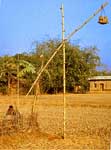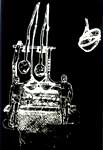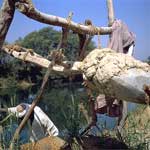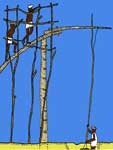 | |  | |  |
| |
The counterpoise lift in Thailand
The counterpoise lift is an ancient invention and has different dimensions according to the depth of the well.
[21] | | The shaduf-bucket on its way down to the bottom of the well
In the northern part of Bangladesh this is a common sight. Here the water table is ten metres below the surface. It needs many hours’ work just to lift enough water for a modest garden.
[22] | | The shaduf in Egypt
Here the water is lifted one or two metres. If it is done by two men, they can irrigate a big "garden".
[23] |
|
 | |  | |  |
| |
Details of a shaduf
This close-up of an Egyptian shaduf should illustrate the construction of the bearing. The correct ratio between the filled bucket and the counterweight is reached by means of a few kilos of clay applied to the lump of concrete.
[24] | | How to make the counterweight when a big stone is not available
This is another close-up of the details of the shaduf. It is the "bottom" of the counterweight. In this part of the Sudan, there are no big stones so a clay lump is built up around a re-inforced construction made of branches and cords. Here the clay has not yet been put in position.
[25] | | The Egyptian shaduf in three stages
Here are two different devices. On the left the peasant draws the pole down to get the bucket filled with water. An anatomist would look at it from a different angle. The peasant lifts the counterweight using the muscles of his arms and legs. If the same bucket should be lifted without the shaduf, he would have to use the muscles of his back. This would injure his back.
[26] |
|
 | | | | |
| |
The shaduf in India (the piccotah) is constructed for a high lift
The bucket is very big and the well is very deep. Therefore, three men are needed. The essential point in this construction is that the two men walk on the beam. Instead of using their backs and hurting their spines, they use the muscles of their legs.
[27] | | | | |
|